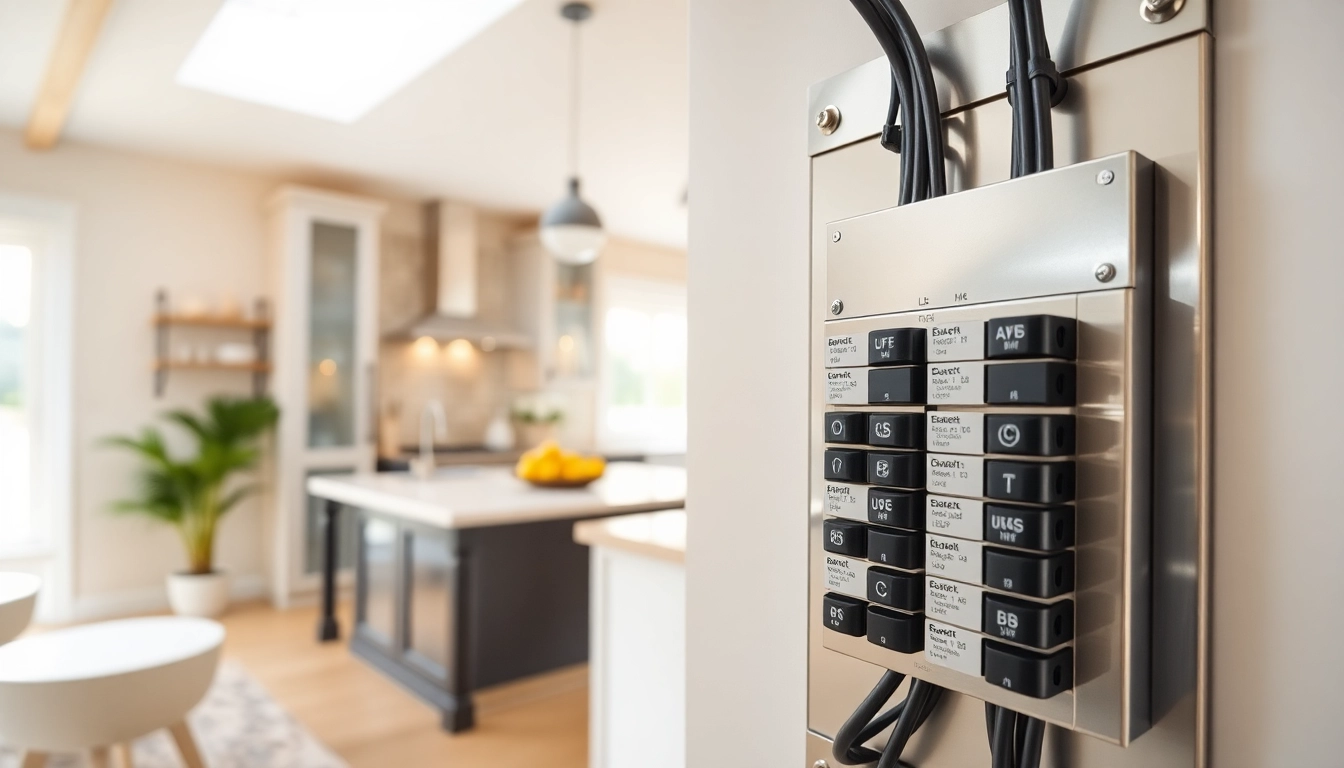What is an Electrical Panel?
Definition and Functionality
An electrical panel, often referred to as a breaker box or power distribution board, is the central hub that manages and distributes electrical power throughout a building. Its primary role is to receive electric power from the utility service and then divide it into multiple circuits for various appliances and outlets. This distribution is essential for ensuring that every aspect of a home or business receives the required voltage while maintaining safety and functionality.
The Electrical Panel serves as the control point for electric flow, with circuit breakers or fuses acting as safety devices that prevent overloads and electrical fires. In the event of a fault or excess current, these breakers will trip and cut the power, protecting both the appliances connected to the circuit and the wiring integrity of the building.
Components of an Electrical Panel
Understanding the components of an electrical panel is crucial for anyone looking to upgrade or maintain their system. Here are the main parts:
- Main Breaker: This is the primary circuit breaker that controls the power supply to the entire panel. It can turn power on or off to all circuits.
- Circuit Breakers: These devices protect individual circuits by interrupting the flow of electricity in case of an overload or short circuit. Each breaker corresponds to a specific circuit in the building.
- Bus Bars: Conductive metal bars that distribute electricity from the incoming power supply to the individual circuit breakers.
- Neutral and Ground Bars: These bars provide a path for electric current to return to its source, ensuring safe operation and reducing the risk of electrical shock.
- Cover: The outer casing of the electrical panel serves to protect the internal components and provides safety against accidental contact.
How Electrical Panels Distribute Power
The distribution of power begins when electricity enters the panel via a service drop or underground service line. It then passes through the main breaker that regulates the flow of electricity before distributing it to individual circuits via bus bars. Each circuit breaker is connected to its respective circuit, allowing for the varied distribution of electrical power according to the demands of different areas and appliances within the building.
This careful distribution not only optimizes the use of electricity but also enhances safety, as it minimizes the risk of overloads on any single circuit. By using circuit breakers, homeowners can manage their electrical consumption efficiently, reducing energy waste and the risk of electrical hazards.
Signs That You Need to Upgrade Your Electrical Panel
Frequent Circuit Breaker Trips
One of the most significant indicators that your electrical panel requires an upgrade is frequent tripping of circuit breakers. If breakers trip regularly, it suggests that the existing panel is not equipped to handle the electrical load required by your household appliances and devices. This repeated interruption can be both inconvenient and a sign of potential safety issues, including the risk of fires.
The first step is to assess your power demands and determine whether your current setup meets these needs. Larger households with multiple electronic devices, particularly high-demand items such as air conditioners and electric ovens, are more likely to experience overloads, necessitating a system capable of managing larger loads.
Increased Power Demands
As homes evolve, so do their electrical needs. The addition of new appliances, smart home systems, and other electronics can significantly increase your power demand. If you are renovating, expanding, or even simply upgrading your home, consider whether your current electrical panel can support these changes.
Modern homes often require more power than older houses designed for fewer electrical devices. If you find yourself constantly running extension cords or relying on multiple outlets, it might be time to evaluate your electrical panel’s capacity.
Age and Condition of the Current Panel
The age of your electrical panel also plays a crucial role in determining whether it should be upgraded. Most panels should last at least 20 to 30 years, but older panels or those with signs of rust, burns, or physical damage could pose a serious safety risk. If your panel is more than three decades old, it may lack the safety features present in modern designs, making an upgrade not only beneficial but essential.
Regular inspection of your panel can help you identify any wear or damage early, potentially avoiding costly repairs or hazardous situations down the line.
Benefits of Upgrading Your Electrical Panel
Improved Safety Features
One of the most compelling reasons to upgrade your electrical panel is enhanced safety. Modern panels incorporate advanced safety features that not only provide better overload protection but also have improved fault detection capabilities. Innovations such as Ground Fault Circuit Interrupters (GFCIs) and Arc Fault Circuit Interrupters (AFCIs) help prevent accidents by monitoring the electrical flow and shutting off circuits before dangerous situations arise.
These features are especially important in areas with higher moisture levels, such as bathrooms and kitchens, where the risk of shock is greater. A new panel can ensure compliance with local electrical codes, which often require the installation of these devices in newly constructed or remodeled homes.
Enhanced Energy Efficiency
Upgrading your electrical panel can lead to significant improvements in energy efficiency. Older panels may not distribute electricity as efficiently, leading to wasted energy. Newer models are designed with energy conservation in mind, helping you save on electricity bills while ensuring that your electrical system operates smoothly.
Additionally, many upgraded panels allow for the integration of renewable energy sources, such as solar power systems, enabling homeowners to charge electric vehicles or other high-demand electrical devices without overloading their systems.
Increased Home Value
Another essential benefit of upgrading your electrical panel is the potential increase in your home’s value. Homebuyers are increasingly looking for modern amenities, including updated electrical systems that can accommodate their lifestyle needs. An electrical panel that is up to code and capable of handling high electrical loads can position your home as more desirable on the market.
Furthermore, investing in upgrades may reduce future maintenance costs and insurance premiums, making your property not only a safer place to live but also a sound financial decision.
Choosing the Right Electrical Panel
Types of Electrical Panels Available
When selecting an electrical panel, it’s crucial to understand the various types available. The most common options include:
- Main breaker panels: These have a main switch that controls all circuits and are suitable for most residential applications.
- Subpanels: These serve to extend power distribution to areas away from the main panel, such as garages or outbuildings.
- Load centers: Ideal for homes with multiple appliances in use, these panels distribute energy more effectively across various high-demand devices.
Choosing the right type of panel will largely depend on the specific electrical needs of your home and the amount of electrical equipment utilized daily.
Factors to Consider When Upgrading
When upgrading your electrical panel, several factors must be taken into account:
- Current and Future Load Requirements: Determine your household’s electricity needs, including existing and potential future loads from new appliances.
- Local Electrical Codes: Ensure that any new panel meets current building codes and regulations in your area.
- Brand and Model: Consider reputable brands known for quality and reliability, as well as warranties offered on new products.
Taking the time to explore these factors can lead to a more informed and satisfying long-term decision.
Consulting with a Professional Electrician
While upgrading your electrical panel might seem straightforward, consulting with a licensed electrician is crucial. Professionals have the expertise to assess your current electrical system, offer recommendations based on safety and efficiency, and ensure that the installation complies with all applicable codes and standards.
Working with an electrician also provides peace of mind that all safety protocols are followed during the upgrade process, reducing the risk of future complications.
Maintaining Your Electrical Panel
Regular Inspections and Testing
Maintaining your electrical panel is as crucial as the installation. Regular inspections can help identify potential issues before they escalate into significant problems. Homeowners should schedule inspections with a qualified electrician at least once every five years or sooner if they notice any signs of issues, such as flickering lights or strange noises from the panel.
During these inspections, electricians will evaluate the condition of breakers, connections, and overall functionality, ensuring that everything operates as intended.
Signs of Maintenance Needs
Addressing maintenance issues promptly is key to a safe and functional electrical system. Look for the following warning signs:
- Discoloration or scorch marks on the panel.
- Burning smells or unusual noises when appliances are used.
- Buzzing sounds coming from the panel.
- Inconsistent performance of electrical devices.
If you notice any of these signs, contact a professional immediately to assess the situation and prevent further issues.
Best Practices for Electrical Panel Care
To ensure your electrical panel remains in optimal condition, adhere to the following best practices:
- Keep the panel covered and free of dust and debris.
- Do not overload circuits by plugging in too many devices.
- Label circuits clearly to ensure users know which breakers control specific areas or appliances.
- Encourage family members to understand basic electrical safety, including what to do in case of a breaker trip.
Maintaining awareness of your electrical system and regular care can significantly extend the life of your electrical panel while enhancing overall safety.



